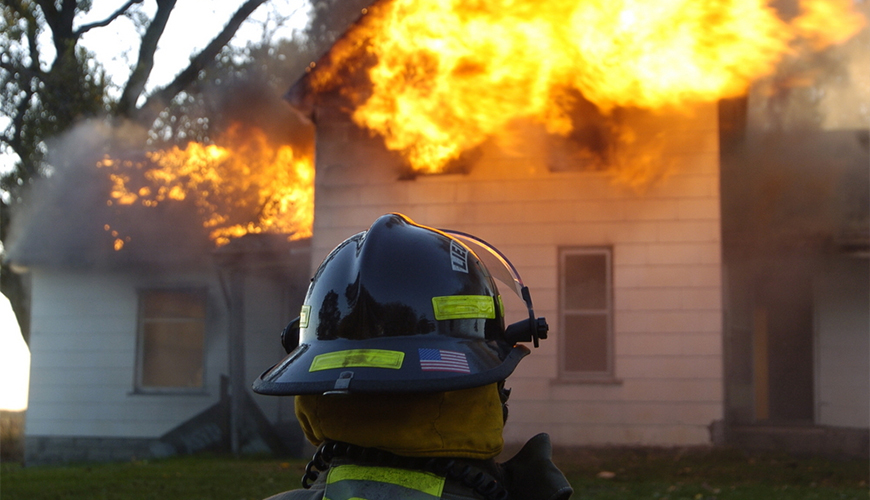
Fire is a complex chemical process, and fire investigators must understand the basic chemistry and physics.
We offer services for-
Fire occurs due to the exothermic reaction of combustion (burning), producing heat and light. In order for a fire to occur, three vital components must be present: a fuel source, an oxidant (O2) and a sufficient amount of energy in the form of heat. Together these make up the fire triangle. A fourth factor can also be described – a self-sustaining chemical chain reaction – to produce the fire tetrahedron. The absence of any of these conditions will result in a fire not starting or extinguishing through smothering (oxygen removal), cooling (heat removal) or starving (fuel removal). Solid and liquid materials do not actually combust, but the process of heating causes them to produce vapours which can burn. This is the process of pyrolysis. Through this pyrolysis products will be formed, flammable and volatile substances of low molecular weight caused through the decomposition of materials by fire. Heat produced by a fire can spread in one of three ways; convection, conduction and radiation. Convection is the transfer of heat through air circulation, and only occurs in liquids and gases. An example of convection is the heat from a fire rising and heating the ceiling of a room.
Matches or lighters can be a primary igniter, along with the associated smoking materials. However, many small appliances, chemicals, and other heat-producing items can be and are a source of heat for uncontrolled fires. The first material ignited has a form or shape, and this too is important. Everything has its own burning characteristics that need to be examined. Ignition will occur when all required conditions to start a fire occur, producing either a smoldering or flaming fire. This will often be induced by the addition of heat to a fuel in air, which can be caused by various sources such as exothermic chemical reactions, friction, solar radiation and electricity.
The temperature required for ignition to occur varies depending on the fuel. The flash point is the minimum temperature at which fuel favor is momentarily ignited in air by an external ignition source. However this will not necessarily sustain combustion and produce a fire. The flame or fire point is the minimum temperature at which enough vapour is produced to allow continued combustion. This is usually a few degrees higher than the flash point. Both the flash and flame point of a substance can be determined by placing a small amount of sample in an airtight container, gradually increasing its temperature whilst periodically adding an ignition source, and then measuring the point at which the flash and flame point is reached. The flash point, flame point and spontaneous ignition temperature are the lowest temperatures at which a material has ignited when heated experimentally, though these actual temperatures can vary and so should only be used as a guideline. Different fuels also have individual lower and upper flammability limits, the lowest and highest concentrations of flammable gas required for combustion.
Although the cause of the fire can only be determined after the area of origin has been located, plenty of supporting evidence of the cause may be uncovered along the path to the fire origin. Examination is started from the farthest point away from the structure where there is no damage at all. Working in a systematic way, the surrounding area for any indications of debris or evidence that may indicate a cause of the fire are to be examined.
If the suspected cause of the fire is an electrical appliance, the equipment must be thoroughly investigated, with a record being kept of details such as the brand, model and serial number. It is first concluded whether the appliance was turned on or off, whether it had a power supply, and whether the power supply was active or if the fuse had blown. Unfortunately an appliance which has caused a fire will most likely have suffered a great deal of damage and so confirming the cause of the fire may be extremely difficult or even impossible.
In the collection of evidence during the investigation of a fire scene, the same rigorous preservation and anti-contamination methods used in crime scene investigation should be employed. In cases of suspected arson, samples are collected from the incident scene for the analysis of accelerants. The use of accelerants is not always apparent; therefore detection dogs or hydrocarbon sniffers to detect these volatile substances are used. Once likely regions have been located, fire test samples are collected from the suspected point of ignition. In addition to this, a control sample should also be obtained, which consists of the same material as that of the fire sample but collected from an area uncontaminated by the suspected fuel, and a negative control sample. When collecting samples of possible accelerants, surface samples may be collected however, in some instances, charring of floors may be too severe. In this case samples can be collected from grooves between or beneath floorboards or even from soil below the floorboards.
During examination on crime scene, it does not matter whether the investigator goes clockwise, counterclockwise, or sets up a grid system. The important fact is that the examination is conducted in a consistent manner from one fire to the next.